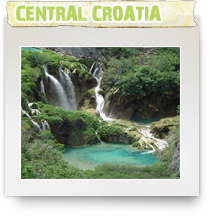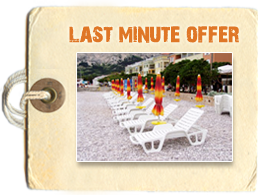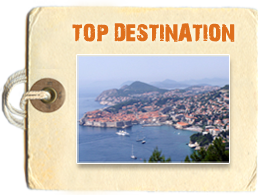
Central Croatia is Croatian region located in the very heart of Croatia.
All these areas are continental, hilly and mountainous areas, and differ very much from Slavonia or Coastal Croatian Areas in terms of landscape as well as climate.
These areas of Croatia are popular destinations for visitors that are not very keen on beaches, but prefer breathtaking mountain views, walks and hikes, skiing in the winter as well as visiting numerous Baroque towns and palaces.
Ogulin | Karlovac | Slunj | Duga Resa | Samobor | Sisak | Krapina | Trakošćan | Čakovec | Koprivnica
Ogulin, is a town in north-western Croatia, Karlovac county, population 8,712 (2001), total municipality population 15,054 (2001). Ogulin has many historical spots such as Kula, the stone castle, and the tall mountain nearby called Klek.
During the Croatian war of independence the town was successfully defended from the rebel Serbs by the 143rd Brigade. The town's local holiday is the Glorification of the Holy Cross on September 14.
The Dobra River runs through town.
Karlovac (German: Karlstadt or Carlstadt, Hungarian: Károlyváros and sometimes in Croatian, "Marinograd") is a city and municipality in central Croatia. The city proper has a population of 49,082, while the whole municipality has a population of 59,395 inhabitants (2001).
Karlovac is the administrative centre of Karlovac county. The city is located on the Zagreb-Rijeka highway and railway line, 56 km south-west of Zagreb and 130 km from Rijeka.
Karlovac used to be known in Croatia as 'grad parkova' (the city of public parks) and 'grad na četiri rijeke' (the town built on four rivers) for its numerous green areas and four beautiful rivers, of which the Mrežnica, the Korana and the Kupa flow through built-up areas, and the Dobra is a few kilometers outside the city centre. These designations are now somewhat forgotten, but the beauty of the nature remains. A documentary film made by Veljko Bulajić in 1979 on the occasion of the 400th anniversary of the founding of the city plays much on that theme, and shows pictures of happy bathers on the Korana's Fogin beach (Foginovo kupalište) in the city centre.
One of the rarer trees found in the parks is the gingko biloba, which primary school children are taken out to see as part of their classes on nature and society. Most of the parks are planted in the former trenches dug around the old military fort that were once filled with water as an added layer of protection from the marauding Ottoman armies. One part of the city centre is still called Šanac ('trench') after those old trenches, which preserve the old hexagonal form of the historic centre.
Slunj, an old town located in northwestern, continental Croatia, is the political and cultural center of the historic region of Kordun. It lies on the Slunjcica river close to the place where it flows into the Korana river, some 50 km from Karlovac that is the transit center on the main road Zagreb - Plitvice lakes - Zadar. Slunj has a lot to offer: rich cultural heritage, old fortified town dating back to 1323, extraordinary landscapes and Rastoke - a fairytale-like mill settlement in which 300 year old wooden houses have been completely renovated and are decorated with flowers and underbrush. If you are headed south or for Dalmatia, spend some time in Slunj and its surroundings, go rafting, rent kayaks or canoes and enjoy the rapids of Korana. Do not forget to taste fish and game specialties. We recommend: source of Slunjcica river / Cetingrad / Rakovica / Rastoke / Plitvice lakes How to get there: 53 km south of Karlovac on the main road Zagreb - Plitvice lakes - Zadar .
Duga Resa is a town and municipality in Karlovac county, Croatia. It is located east of Rijeka.
Duga Resa was first mentioned in records back in 1380. There are several theories on how the then-village got it's name: one is that "resa" is reference to the town people's folk costumes, another is that it is named from the native plant that grows in the area, both on the land and in the water.
The village soon grew into a town during the industrialization of the area in the late 19th and early 20th century. Today, there are 12,114 inhabitants in the municipality, 96% which are Croats. It's geographic location gives the town very hot summers and very cold winters.
Popular activities include fishing, rafting, hunting, boating, swimming, volleyball, soccer, and biking. The local church St. Peters (Sveti Petar) dates back to the 14th century.
Samobor, is a city in Zagreb county, Croatia, population 36,206 (2001). It is located to the west of Zagreb, between the eastern slopes of Samoborsko gorje (Samobor hills, the eastern part of the Žumberak Mountains), in the Sava river valley. It is part of the Zagreb metropolitan area, and the County of Zagreb (Zagrebačka županija).
Samobor has existed as a free royal town since 1242 according to a document of endowment by King Bela IV. Its history and culture are rich and various. It is one of the earliest tourist resorts in the region, with the first tourist facilities dating back to 1810, oriented towards anglers, hunters and hikers. The town's beautiful surroundings and vicinity to the capital have been supporting this tourist tradition to the present day. Many famous Croats were born or lived in Samobor. Such notable personalities are: Ferdo Livadić Wiesner, piano composer and the writer of the most famous Croatian patriotic song (budnica), 'Još Hrvatska ni propala' ('Croatia hasn't perished yet'); A.G. Matoš, poet and writer, who abode in Samobor for only four years; and Milan Lang, reformer of education in Croatia and teacher in the Samobor school. In 1846, Samobor was paid a visit by the composer Franz Liszt, who at that time was visiting Zagreb during one of his numerous concert-tours. Liszt came to Samobor to see his friend, previously mentioned Ferdo Livadić.
One of the chief industries in Samobor is crystal cutting. Some of the best crystal in Europe comes from Samobor and is highly prized all over the world.
Sisak, (German: Sissek, Hungarian: Sziszek, Italian: Siscia) is a city in central Croatia. The city's population in 2001 was 52,236 [1] and it is the administrative centre of Sisak-Moslavina county. Sisak is located at the confluence of the Kupa, Sava, and Odra rivers, 57 km southeast of the Croatian capital Zagreb.
Sisak is usually considered to be where the Posavina (Sava basin) begins, with an elevation of 99 m.
Sisak is Croatia's biggest river port and a centre of river shipping industry (Dunavski Lloyd). Sisak lies on the main road Zagreb-Sisak-Petrinja (M12.2) and the railroad Zagreb-Sisak-Sunja.
The best of travelling trough the middle part of Croatia is with a car. The roads are mainly in good shape. Heading from Zagreb there is a highway, A11 to Samobor and the nature park Lonjsko Polje. The highway A12 leads to Jastrebarsko and Karlovac. Croatian road 30 leads to Sisak. Offcourse there are many B roads to all the middle Croatian villages.
All main middle Croatian villages are connected with the Croatian railroad ('Hrvatske zeljeznice/HZ') except the city of Samobor.
All cities and villages are within reach of bus connections.
Krapina is the main cultural centre of Hrvatsko Zagorje. The town features very rich historical and cultural heritage, which makes it also an important tourist centre. The major tourist attraction of Krapina are the remains of the Pleistocene (prehistoric) man of the Neanderthal type (Homo crapiniensis) on the Husnjakovo hill, discovered at the end of the 19th century, which represent one of the most important Neanderthal sites in the world. Important as a tourist area is also the urban core of Krapina with some well preserved town palaces.
Trakošćan
One of the most attractive Croatian medieval castles and historic sites, Trakošcan, with its forest-park, lake and nature-trail, its museum and well-preserved interior, is rightly called ''the pearl of Hrvatsko Zagorje''.
The castle was built at the end of the 13th Century in the picturesque Bednja Valley, surrounded by the meadows, forest, and small vineyards of the gently sloping Zagorje mountains: Strahinjšcica (847 m.), Macelj (715 m.), Ravna Gora (686 m.) and the tallest, Ivanšcica (1061 m.)..
Varazdin, Baroque Capital of Croatia : A jewel of harmony and intimacy, the charm of ''Croatia's Vienna'' lies not only in its architecture, but also in its atmospheric squares and lovely streets. The buildings, museums, music and flowers of Varaždin continue to offer a relaxing break from everyday life. The city's rich history spans eight centuries. It was home to the region's wealthiest nobles, landowners, artisans and artists, especially in the late 1700s, when the city flourished and became the capital of Croatia. Find the best deal, compare prices and read what other travelers have to say about hotels in Varazdin
Čakovec is a city located in northern part of Croatia and the second northernmost city of the country. Being located in the central part of the Međimurje County as well as being the largest of its three cities, Čakovec is also the county seat of this northernmost and smallest Croatian county, which is located between the rivers Mura and Drava and well known for its vineyards, agriculture and hunting grounds.
Koprivnica is a city in northern Croatia with a population of 30,994 (2001), the capital of the Koprivnica-Križevci county.





